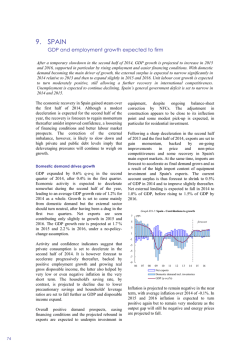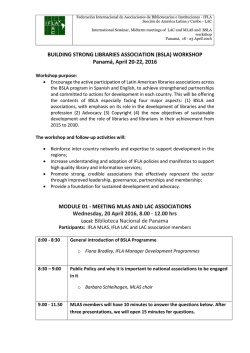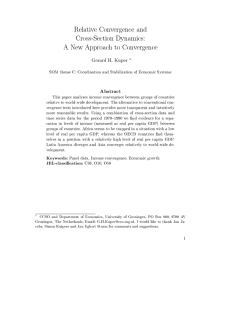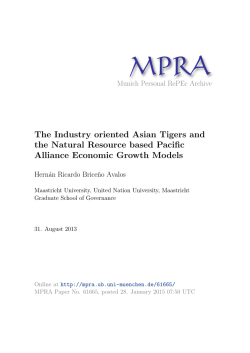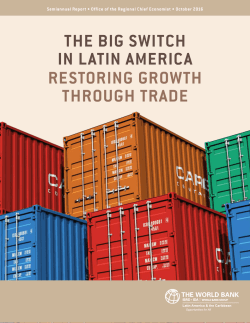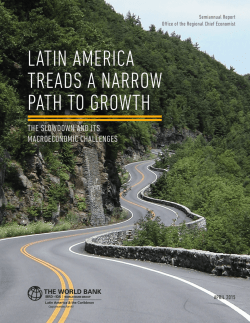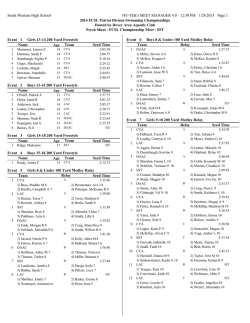
Read Report - World Bank
GLOBAL ECONOMIC PROSPECTS | January 2015 Latin America and the Caribbean Growth in Latin America and the Caribbean slowed markedly to 0.8 percent in 2014 but with diverging developments across the region. South America slowed sharply as domestic factors, exacerbated by China’s cooling economy and declining global commodity prices, took their toll on some of the largest economies in the region. In contrast, growth in North and Central America was robust, lifted by strengthening activity in the United States. Strengthening exports on the back of the continued recovery among high-income countries and robust capital flows should lift regional GDP growth to an average of around 2.6 percent in 2015–17. A sharper-than-expected slowdown in China and a steeper decline in commodity prices represent major downward risks to the outlook. Recent Developments contraction in the first half of 2014. Argentina’s credit rating downgrade to selective default will hinder access to international capital markets, adding downside risks to its outlook, which was partly mitigated by a bumper soy harvest. Recent sharp declines in oil prices have raised investors’ doubts about República Bolivariana de Venezuela’s ability to service its debts, pushing yields on its U.S. dollar denominated sovereign bonds to 26 percent, the highest sovereign yield in the world. Aggregate regional growth declined considerably to 0.8 percent in 2014 because of declining commodity prices, a slowdown in major trading partners, and domestic tensions in some of the larger economies (Figure 2.15, Table 2.5). Regional growth was less than a third of that in 2013, and was the slowest in over 13 years, with the exception of 2009. Nevertheless, there were diverging trends across sub-regions and countries. With continued robust expansions in Bolivia, Colombia, Ecuador, and Paraguay and sharp slowdowns in Argentina, Brazil, and República Bolivariana de Venezuela, South America decelerated sharply from 2.9 in 2013 to 0.2 percent in 2014. In contrast, because of its close proximity to a strengthening United States, growth in developing North and Central America picked up to 2.4 percent in 2014, led by Mexico. Underpinned by robust mining exports and services, rapid growth in the Dominican Republic contributed to stronger growth in the Caribbean of 4.6 percent in 2014. With continued strengthening of the United States and the Euro Area recovering slowly, export growth picked FIGURE 2.15 GDP growth, 2013 and 2014 Growth slowed down in 2014 with divergence among sub-regions Percent 2013 2014 Mexico The Dominican Caribbean Republic 7 6 5 4 3 In the region’s largest economy, Brazil, protracted declines in commodity prices, weak growth in major trading partners, severe droughts in agricultural areas, election uncertainty, and contracting investment have contributed to a steep decline in growth. The central bank has raised interest rates to fight inflation and credit conditions have tightened. Growth in Brazil is therefore expected to remain weak at least in the short run, with a 2 1 0 Latin America & the Caribbean South America Brazil Source: World Bank. Note: GDP-weighted real GDP growth. 1 North & Central America GLOBAL ECONOMIC PROSPECTS | January 2015 Latin America and the Caribbean FIGURE 2.16 Exchange rates, 2013–14 up in 2014 despite softening global commodity demand. Aside from trading partner growth, a variety of countryspecific factors buoyed exports. These included a bumper soy harvest (Argentina), strong gas production and exports to Argentina and Brazil (Bolivia), and large gold shipments (Dominican Republic). In contrast and as an exception in the region, Brazilian exports contracted modestly because of weak demand in major trading partners Argentina and China. The depreciations of mid-2013 have persisted and intensified in some countries in late 2014. US$/LCU index (May 22, 2013=100) 110 Brazil Colombia Mexico Peru 105 100 95 90 Substantial currency depreciations since May 2013 have persisted and, in some cases, intensified in late 2014, bolstering competitiveness (Figure 2.16). By endNovember 2014, the Colombian peso, Costa Rican colon, Mexican peso, and Peruvian nuevo sol had depreciated, on average, by 10.7 percent in nominal terms and around 5.8 percent in real effective terms since April 2013, just prior to the mid-2013 financial market volatility. The depreciations of the Brazilian real (20.1 percent nominal, 12.2 percent real) and Jamaican dollar (13.1 percent nominal) were especially deep, largely because of investor concerns about macroeconomic imbalances. Following the 18 percent devaluation in late January 2014, the Argentine peso gradually depreciated further throughout the year. Through a new dollar auction system created in early 2014, the Venezuelan government has effectively devalued the bolivar. 1 85 80 Nov-14 Sep-14 Jul-14 May-14 Mar-14 Jan-14 Nov-13 Sep-13 Jul-13 May-13 Jan-13 Mar-13 75 Source: Haver Analytics. FIGURE 2.17 Impact of declining commodity prices on trade balances, 2013–14 Projected declines in commodity prices are expected to worsen trade balances less than in 2013. Percent of GDP 2013 3 2014 1 -1 -3 -5 -7 Suriname Guyana Paraguay Nicaragua Peru Guatemala Bolivia Belize Honduras Colombia Argentina LAC region El Salvador Jamaica Brazil Ecuador Mexico Venezuela,R.B. Panama Costa Rica Dominican Rep. Dominica Haiti Falling commodity prices led to diverging terms of trade effects, especially between oil exporters and oil importers (Figure 2.17). While declining oil, metal, agriculture, and precious metal prices worsened the terms-of-trade for regional commodity exports in 2014 and dented regional exports—although less than in 2013—they improved the terms-of-trade of commodity importers. Nicaragua, in particular, benefited from the rebound in beef and coffee prices, which surged 23–40 percent in 2014, after falling 2013. In contrast, metals price declines hit Suriname, a major exporter of gold and aluminum (around 90 percent of its exports), particularly hard. On balance, the region’s current account deficit was broadly stable at about 2.6 percent of GDP in 2014. Source: World Bank. Note: Based on the assumption of a 7 percent annual average decline in oil prices, a 2 percent annual average decline in agricultural commodity prices and a 6 percent annual average decline in metals and minerals prices between 2013 and 2014. FIGURE 2.18 Gross capital flows, 2013–14 Capital flows initially rebounded from January/February weakness but then softened again on policy uncertainty. Billions, US$ Bank loans Bond issue Equity issue 30 25 20 15 10 1Public-sector and high priority imports are eligible for the official rate (BsF6.3:US$1), while the private sector may purchase U.S. dollars through one of the two auction system in place: Sicad was created in early 2013 and auctions dollar at the around BsF12:US$1; Sicad 2 was created in early 2014 and auctions dollar at around BsF50:US$1. Additionally, due to difficulties in accessing dollar through these official mechanism, private sector has had buy dollar or on the black market, where the exchange rate is currently around BsF175:US$1. In real effective terms, however, the bolivar has appreciated more than 100 percent because of high inflation rates. 5 Nov-14 Sep-14 Jul-14 May-14 Mar-14 Jan-14 Nov-13 Sep-13 Jul-13 May-13 Mar-13 Jan-13 0 Sources: Dealogic and World Bank. Note: Gross capital flows includes gross equity and bond issuance and syndicated lending. Secondary trading in securities not included. 2 GLOBAL ECONOMIC PROSPECTS | January 2015 Latin America and the Caribbean FIGURE 2.19 Monetary policy rates FIGURE 2.20 Change in fiscal balances, 2013–14 Except in Brazil and Colombia, monetary policy rates were on hold or lowered since mid-2014. Structural fiscal deficits widened in an effort to support growth. Percent 12 Brazil Colombia Dominican Rep. Honduras Mexico Peru . Percent of GDP 3 General government net lending/borrowing Structural balance Guatemala 2 10 1 8 0 6 4 -2 Nov-14 Sep-14 Jul-14 May-14 Jan-14 Mar-14 Nov-13 Jul-13 Sep-13 Mar-13 May-13 Jan-13 Nov-12 Jul-12 Sep-12 May-12 Jan-12 Mar-12 2 Source: Haver Analytics. Note: Official (nominal) policy interest rates: Brazil (Selic), Colombia (BDLR Intervention Rate), Dominican Republic (Overnight Rate), Honduras (Monetary Policy Rate), Mexico (Tasa Objetivo), Peru (Tasa de Interés de Referencia), Guatemala (Leading Interest Rate). Brazil Argentina Bolivia Panama Jamaica Peru Costa Rica El Salvador Colombia Mexico Nicaragua Guatemala Paraguay Dominica Ecuador Belize Dom. Rep. Venezuela. R.B. Guyana Grenada Haiti Honduras Suriname -1 Sources: IMF World Economic Outlook and Brazilian Central Bank. Note: The structural fiscal balance adjusts the overall fiscal balance for the business cycle and one-off revenues and expenditures. Gross capital flows to the region slowed significantly in 2014 (Figure 2.18), partly reflecting weak activity. This was largely accounted for by a sharp drop in equity flows to Brazil and Mexico, where weakening growth prospects discouraged investors. In contrast, bond issuance reached the highest volumes on record in late 2014, as prospects of U.S. monetary tightening spurred a surge of refinancing and pre-financing by Latin American borrowers, especially in Brazil and Mexico, which combined accounted for 76 percent of region’s total bond issues in 2014. government revenues, fiscal deficits, on average, widened somewhat from 4.0 percent in 2013 to around 5.2 percent of GDP in 2014. Structural balances deteriorated as governments loosened fiscal policies to support growth. For example, Brazil’s fiscal deficit surged in 2014 as the government implemented stimulus measures, including tax breaks and an expansion of public lending to stem the growth slowdown. Outlook Amid generally modest inflation, monetary policy continues to be accommodative with recent cuts in Guatemala, Mexico, and Peru to support growth. Policy rates in most countries remained below 3 percent in real terms in 2014 (Figure 2.19), with real rates in a few countries even turning negative. In contrast, the Central Bank of Brazil, citing inflation concerns, resumed tightening after a six-month pause, raising the benchmark Selic rate to 11.75 percent, a cumulative increase of 450 basis points in the tightening cycle that began April 2013. The central bank of Colombia also increased the benchmark interest rate, in several smaller steps, in 2014, from 3.25 percent to 4.5 percent. To support growth in the medium term, monetary policy in the region is expected to remain broadly accommodative provided that inflation pressures remain contained. Aggregate regional growth is expected to accelerate on strengthening exports and investment. The recovery in advanced countries is expected to support external demand growth despite the carefully managed slowdown in China and soft commodity prices. Although financing conditions gradually tighten in the baseline forecast, domestic demand growth should pick up after bottoming out in 2014. On balance, regional growth is expected to further strengthen to 2.6 percent on average over 2015– 17. While continuing to be positive, the current outlook is significantly less favorable than the pre-crisis period of 2004–2008, when growth averaged more than 5 percent per annum, driven by the double tailwinds of booming commodity markets and surging external demand. The Caribbean is projected to lead regional growth, averaging 4.1 percent over 2015–17 (Figure 2.21), benefiting from stronger external demand and rising tourism receipts. Countries in developing North and Fiscal balances deteriorated and fiscal policy loosened in much of the region in 2014 (Figure 2.20). Amid lower commodity prices, slower growth, and weakening 3 GLOBAL ECONOMIC PROSPECTS | January 2015 Latin America and the Caribbean FIGURE 2.21 GDP growth, 2014–17 Brazil assumes that with the new economic team in place, growth-supporting policies will strengthen. In that light, the tepid recovery in the second half of 2014 is expected to continue into 2015, with investment slowly strengthening, as a result of improved investor confidence and the boost to exports created by the depreciated real. In the medium term, however, structural impediments to growth, such as poor infrastructure and cumbersome tax and labor regulations, will continue to subdue growth. While projected to still undergo adjustment and remain weak in 2015, Argentina and República Bolivariana de Venezuela are expected to slowly rein in government expenditures, re-anchor inflation expectations, and thereby reduce inflation. Consumer and investor confidence will gradually return, leading to strengthening domestic demand in the second half of the forecasting horizon. Growth is expected to gradually accelerate in all subregions except the Caribbean. Percent 5 2014 2015 2016 2017 4 3 2 1 0 Latin America & the Caribbean South America Developing North & Central America Caribbean Source: World Bank. Note: GDP-weighted averages. However, a number of other countries are projected to see favorable developments in the medium term, partially offsetting the slow recovery of the largest countries and lifting regional growth. While the partial withdrawal of Intel will have significant near-term effects on growth, prospects remain positive for Costa Rica in the medium term on robust investment growth, spurred by the Dominican Republic-Central America-United States Free Trade Agreement and supported by increasing economic openness and a business-friendly tax regime. Colombia, the fourth largest recipient of FDI in the region, will continue to be attractive to investors with its sound macroeconomic fundamentals, and continued focus on further improving the business environment, leading to robust fixed investment growth in the medium term. Similarly, despite the continued delay in elections, Haiti is projected to see a modest pickup in growth with strong expansion in construction, industrial output and commerce, and, in particular, apparel exports with the opening of the new Caracol Industrial Park in the northeast. Central America are expected to expand at an average of 3.7 percent as potential growth rises on reform dividends. As a result of persistent policy uncertainty and soft commodity prices, South American economies will likely accelerate at a somewhat lower pace, averaging 2.2 percent over the forecast horizon. Across the region, the tilting of growth away from domestic demand towards exports is expected to narrow current account deficits. The recovery taking hold in advanced economies will strengthen export demand, offsetting the impact of China’s adjustment to a more sustainable long-term rate of growth. While there are substantial compositional differences between the export baskets to China and to advanced countries, the increased demand from the latter (mainly manufactures) is projected to more than offset the decline in Chinese demand (mainly primary commodities). In addition, rising tourism receipts will support activity. Competitiveness gains from depreciated local currencies will help some countries gain global market share. Following their fall in 2014, commodity prices are expected to remain soft. Balance of payments pressures for non—energy commodity exporters will be further mitigated by rising remittances from high-income economies. Despite tightening global financial conditions expected for 2015, net capital flows to the region are expected to rise gradually, supporting investment growth. With the soft oil prices posing substantial downside risks for oil exporters, Ecuador is expected to see even stronger growth from 2016 as new production from the Ishpingo, Tambococha, and Tiputini (ITT) fields comes onstream. Driven by large-scale investment projects, Panama has the most rapid rate of expansion in 2014 in the region. The stimulus provided by public construction is projected to subside in the medium term, especially after the conclusion of the canal expansion in 2016, but should be partially replaced by increased tourism and services exports generated by the expanded canal. Despite the plunge in copper prices, Peru’s outlook remains positive on sound macroeconomic policies and substantial commodity wealth. Peruvian GDP growth is Domestic constraints among the regions’ largest economies are also expected to gradually loosen in the medium term. Despite the removal of electoral uncertainty, uncertainty about monetary and fiscal policies and the structural reform agenda remains elevated in Brazil. However, the baseline forecast for 4 GLOBAL ECONOMIC PROSPECTS | January 2015 Latin America and the Caribbean FIGURE 2.22 Share of commodities in total exports, 2010–12 average expected to rebound sharply in the medium term, supported by government stimulus, implementation of large new infrastructure projects, and two mining megaprojects coming online in the next two years. Countries with large shares of commodity exports will be more sensitive to commodity price declines. Percent of total exports 70 Agricultural Metals Energy 60 Risks 50 40 30 20 The balance of risks in the Latin America and Caribbean (LAC) region, as in others, leans heavily towards the downside. The downside risks are both external and internal to the region and include the following: 0 Bolivia Venezuela, RB Ecuador Jamaica Colombia Brazil Paraguay Peru Guyana Belize Argentina Honduras Guatemala Nicaragua Dominica Mexico Panama El Salvador Dominican Republic Costa Rica Haiti St. Vincent & the Grenadines Suriname 10 Financial volatility. Tightening global liquidity conditions following the expected first monetary policy hikes in the United States could trigger sharp swings in capital flows and large asset price and exchange rate movements, as investors reappraise long-term returns and attempt to exit less profitable investments. Given a continued strong U.S. dollar, capital flows to the region could stall or reverse, choking off financing for consumer durables and investment, and weighing on growth. Risks will be most pronounced among developing economies where short-term or foreign debt or both represents a large proportion of overall debt, or where credit has been expanding rapidly in recent years. Source: UN Comtrade. Note: Using a consistent cross-country methodology; may differ from country sources (e.g. for Peru) that use a different classification or more updated data. to commodity price declines (Figure 2.22). However, lower oil prices in the medium term will represent an upside risk for oil-importing economies in the region. Disorderly slowdown in the region’s largest economies. Three of the region’s largest economies, Argentina, República Bolivariana de Venezuela, and to a much less severe extent, Brazil, are currently grappling with elevated inflation in a low-growth environment, and risks to their outlooks are tilted to the downside. Given the systemic nature of these economies in the region, weaker-than-expected growth in one or more of these three economies could have a contagion effect across the region. For example, a disruption to low-priced oil supplies from República Bolivariana de Venezuela, under the Petrocaribe program, could sharply dent activity in some Caribbean and South American countries. Escalation in violence. The region remains one of the most violent in the world. Compared to the global average murder rate of 6.2 per 100,000 population, the murder rate in South America, Central America, and the Caribbean are around 24, 26, and 19 respectively (United Nations Office on Drugs and Crime, 2014). If crime and violence escalate, the region’s business environment will turn less conducive and become a drag on investment and economic growth in the medium and extended term. Policy Challenges Tax revenues in the region remain overreliant on indirect taxes, which are regressive, and on commodity exports, which are volatile and leave public finances heavily exposed to external shocks. Across the region, reforms are needed to simplify and rebalance the complex tax systems, so as to reduce incentives to shift to informal economic activities and to achieve a more resilient revenue base. Sharper-than-expected decline in commodity prices. The baseline assumes that commodity prices remain soft, following their slides in late 2014. A sharper-thanexpected slowdown in China could lead to more severe declines in commodity prices, which could further erode exports and government revenues of regional commodity exporters and widen current account deficits in the region (Box 2.2). Investment, especially in mining industries, would fall. Countries with higher shares of commodity exports would be more sensitive Underdeveloped infrastructure is another major constraint on the region’s ability to achieve higher sustained growth. Public investment in infrastructure has never recovered from the substantial cuts made under the stabilization programs of the 1990s. Regional 5 GLOBAL ECONOMIC PROSPECTS | January 2015 Latin America and the Caribbean infrastructure investment averaged 2.7 percent of GDP per annum in the last decade. However, an investment of 6.2 percent of GDP is estimated to be required to satisfy the region’s infrastructure demand in the period 2012–20 (ECLAC, 2014). To ease fiscal constraints, recent efforts to increase infrastructure investment include greater private sector involvement, for example, through publicprivate partnerships. Several governments have proceeded to implemented reforms, although often slowly and in an uncoordinated manner, partly as a result of fragile governments. Mexico, the Dominican Republic, and Chile have had particular reform momentum. A key concern for the region is that slower long-term growth—around 2–3 percent per annum—might become the “new normal.” The past 15 years may, ex post, turn out to have been a double tailwind era—booming commodity market and rapidly growing export demand. With this era fading, economies near or at full employment, and domestic credit growth slowing, the region must sustain long-term growth through enhanced productivity growth. The quality of the workforce, especially in the informal sector, needs to be upgraded; research, development, and innovation fostered; and more competitive environment, especially in the service sector, nurtured. 6 In Mexico, a number of reforms were signed into law in 2013 and 2014, including education, energy, and telecommunications reforms. Full implementation should remove some of Mexico’s binding constraints to growth. The Dominican Republic is pursuing education, labor, energy, and fiscal pacts, with the first already agreed, and other reforms currently under discussion. Chile enacted a tax reform in September 2014 that is expected to yield additional revenue. The government is now focused on education reform and the pension system. GLOBAL ECONOMIC PROSPECTS | January 2015 TABLE 2.5 Latin America and the Caribbean Latin America and the Caribbean forecast summary (Annual percent change unless indicated otherw ise) 00-10a 2011 2012 2013 2014e 2015f 2016f b GDP at m arket prices 3.3 4.2 2.6 2.5 0.8 1.7 2.9 (Average including countries w ith full national accounts and balance of payments data only) c 2017f 3.3 GDP at m arket prices c 3.3 4.2 2.6 2.5 0.8 1.7 2.9 3.3 GDP per capita 1.9 3.0 1.4 1.4 -0.3 0.7 1.9 2.2 PPP GDP 3.2 4.4 2.7 2.7 1.1 2.0 3.1 3.4 Private consumption 3.6 5.1 4.1 3.2 0.9 1.5 2.3 2.7 Public consumption 3.3 3.0 4.1 2.6 2.4 1.6 2.3 2.4 Fixed investment 4.8 8.0 2.0 2.2 -2.3 1.7 4.2 5.0 Exports, GNFSd 2.8 6.8 3.1 0.9 2.0 3.3 4.2 4.7 Imports, GNFSd 5.7 11.0 4.8 2.6 0.5 2.2 3.2 3.9 Net exports, contribution to grow th -0.4 -0.8 -0.4 -0.4 0.3 0.2 0.2 0.1 Current account balance (percent of GDP) -0.5 -1.5 -1.8 -2.5 -2.6 -2.8 -2.5 -2.2 7.0 7.5 6.7 9.8 13.9 … … … -2.6 -3.1 -3.6 -4.0 -5.2 -4.2 -4.1 -4.1 3.3 4.2 2.7 2.6 0.9 1.8 2.9 3.3 3.7 4.2 2.1 2.9 0.2 1.1 2.5 3.0 2.0 4.2 4.1 1.5 2.4 3.4 3.9 3.9 Caribbean 3.4 2.8 2.0 3.7 4.6 4.1 4.2 4.2 Brazil 3.6 2.7 1.0 2.5 0.1 1.0 2.5 2.7 Mexico 1.8 4.0 4.0 1.1 2.1 3.3 3.8 3.8 Argentina i 3.8 8.6 0.9 2.9 -1.5 -0.3 1.6 3.1 Consum er prices (annual average) Fiscal balance (percent of GDP) Mem o item s: GDP Broader geographic region (incl. recently high income countries) e South America f Developing Central and North Americag h So urce: Wo rld B ank. Wo rld B ank fo recasts are frequently updated based o n new info rmatio n and changing (glo bal) circumstances. Co nsequently, pro jectio ns presented here may differ fro m tho se co ntained in o ther B ank do cuments, even if basic assessments o f co untries’ pro spects do no t differ at any given mo ment in time. a. Gro wth rates o ver intervals are co mpo und weighted averages; average gro wth co ntributio ns, ratio s and deflato rs are calculated as simple averages o f the annual weighted averages fo r the regio n. b. GDP at market prices and expenditure co mpo nents are measured in co nstant 2010 U.S. do llars. c. Sub-regio n aggregate excludes Cuba, Grenada, and Suriname, fo r which data limitatio ns prevent the fo recasting o f GDP co mpo nents o r balance o f payments details. d. Expo rts and impo rts o f go o ds and no n-facto r services (GNFS). e. Recently high-inco me co untries include Chile, Trinidad and To bago , and Uruguay. f. So uth A merica: A rgentina, B o livia, B razil, Co lo mbia, Ecuado r, Guyana, P araguay, P eru, Venezuela g. Develo ping Central & No rth A merica: Co sta Rica, Guatemala, Ho nduras, M exico , Nicaragua, P anama, El Salvado r. h. Caribbean: B elize, Do minica, Do minican Republic, Haiti, Jamaica, St. Lucia, St. Vincent and the Grenadines. i. P reliminary fo r lo ng-term average. Data was recently rebased; missing data up to 2003 was spliced with the earlier data. 7 GLOBAL ECONOMIC PROSPECTS | January 2015 TABLE 2.6 Latin America and the Caribbean Latin America and the Caribbean country forecast (Real GDP grow th at market prices in percent and current account balance in percent of GDP, unless indicated otherw ise) 00-10a Argentina 2011 2012 2013 2014e 2015f 2016f 2017f b GDP 3.8 8.6 0.9 2.9 -1.5 -0.3 1.6 3.1 Current account balance 1.8 -0.7 -0.2 -0.8 -1.4 -1.2 -0.7 -0.1 Belize GDP 4.0 2.1 4.0 0.7 2.6 2.6 2.7 2.8 -11.8 -1.1 -1.2 -4.5 -5.3 -6.2 -6.4 -6.5 GDP 3.8 5.2 5.2 6.8 5.3 4.5 4.3 4.0 Current account balance 4.0 2.2 7.9 4.3 2.3 -0.2 -1.3 -2.0 Current account balance Bolivia Brazil GDP Current account balance 3.6 2.7 1.0 2.5 0.1 1.0 2.5 2.7 -0.9 -2.1 -2.4 -3.6 -3.8 -3.6 -3.4 -3.2 Colom bia GDP Current account balance 4.1 6.6 4.0 4.7 4.7 4.4 4.3 4.3 -1.5 -2.9 -3.1 -3.2 -4.0 -4.3 -4.0 -3.7 Costa Rica GDP Current account balance 4.4 4.5 5.1 3.5 3.7 4.1 4.2 4.5 -4.8 -5.4 -5.3 -4.9 -4.7 -4.1 -4.0 -3.8 Dom inica GDP Current account balance 2.6 0.2 -1.1 0.8 1.5 1.3 1.5 1.6 -18.6 -14.5 -18.9 -16.6 -17.0 -16.1 -15.2 -14.0 Dom inican Republic GDP Current account balance 4.9 2.9 2.6 4.6 5.9 4.9 4.7 4.7 -3.5 -7.9 -6.8 -4.1 -3.4 -3.1 -2.9 -2.8 Ecuador GDP 4.1 7.8 5.1 4.5 4.0 3.8 4.3 5.0 Current account balance 0.1 -0.4 -0.4 -1.3 -0.2 -2.9 -1.8 -0.6 El Salvador GDP Current account balance 1.9 2.2 1.9 1.7 1.9 2.4 2.7 2.9 -4.1 -4.8 -5.4 -6.5 -5.9 -5.8 -5.7 -5.6 Guatem ala GDP Current account balance 3.3 4.2 3.0 3.7 3.5 3.6 3.6 3.5 -4.3 -3.4 -2.6 -2.7 -2.0 -1.9 -1.8 -1.7 Guyana GDP Current account balance 2.4 5.4 4.8 5.2 3.6 3.7 3.8 4.0 -10.1 -13.1 -11.6 -12.9 -15.4 -15.3 -15.0 -14.6 Haiti GDP 0.1 5.5 2.9 4.3 3.6 3.8 4.1 4.1 Current account balance 1.3 -4.3 -5.7 -6.7 -6.2 -6.1 -5.9 -5.8 4.1 3.8 4.1 2.6 3.0 3.0 3.3 3.5 -6.6 -8.0 -8.5 -9.5 -7.1 -6.8 -6.6 -6.6 Honduras GDP Current account balance Jam aica c GDP Current account balance 0.7 1.7 -0.6 0.6 0.9 1.1 2.2 2.5 -9.8 -13.4 -13.0 -11.1 -8.4 -7.1 -5.9 -5.0 1.8 4.0 4.0 1.1 2.1 3.3 3.8 3.8 -1.4 -1.1 -1.3 -2.1 -2.1 -2.4 -2.2 -2.2 Mexico GDP Current account balance 8 GLOBAL ECONOMIC PROSPECTS | January 2015 TABLE 2.6 Latin America and the Caribbean (continued) (Real GDP grow th at market prices in percent and current account balance in percent of GDP, unless indicated otherw ise) 00-10a Nicaragua 2011 2012 2013 2014e 2015f 2016f 2017f b GDP Current account balance 2.8 5.7 5.0 4.6 4.2 4.4 4.5 4.3 -12.4 -12.8 -12.7 -11.4 -10.8 -9.2 -9.5 -10.1 Panam a GDP Current account balance 6.3 10.9 10.8 8.4 6.5 6.1 5.8 5.6 -5.2 -15.9 -10.6 -11.9 -12.3 -12.0 -11.1 -10.0 Paraguay GDP 3.4 4.3 -1.2 14.2 4.0 4.3 4.3 4.6 Current account balance 1.5 -1.1 -0.9 2.1 1.1 -1.1 -0.6 -0.7 Peru b GDP Current account balance 5.6 6.5 6.0 5.8 2.4 4.8 5.5 5.9 -0.9 -1.9 -3.3 -4.5 -4.8 -4.2 -3.9 -3.6 St. Lucia GDP 1.8 1.2 -1.6 -0.4 -1.0 -0.6 0.8 1.4 -18.1 -18.9 -14.2 -7.4 -7.7 -8.6 -9.4 -10.0 2.9 -0.5 1.2 1.7 1.5 2.6 2.9 3.4 -19.9 -29.4 -31.1 -32.9 -33.5 -33.0 -32.4 -31.6 GDP 3.1 4.2 5.6 1.3 -3.0 -2.0 0.5 1.5 Current account balance 9.0 7.7 2.9 2.5 2.0 -0.3 -0.5 -0.6 Current account balance St. Vincent and the Grenadines GDP Current account balance Venezuela, RB So urce: Wo rld B ank. Wo rld B ank fo recasts are frequently updated based o n new info rmatio n and changing (glo bal) circumstances. Co nsequently, pro jectio ns presented here may differ fro m tho se co ntained in o ther B ank do cuments, even if basic assessments o f co untries’ pro spects do no t significantly differ at any given mo ment in time. Cuba, Grenada, St. Kitts and Nevis, and Suriname are no t fo recast o wing to data limitatio ns. a. GDP gro wth rates o ver intervals are co mpo und average; current acco unt balance shares are simple averages o ver the perio d. b. P reliminary fo r lo ng-term average. Data was recently rebased; missing earlier data was spliced with the previo us series. c. Fiscal year basis. 00-10a Recently transitioned to high income countries Chile 2011 2012 2013 2014e 2015f 2016f 2017f b GDP 4.1 5.8 5.5 4.2 1.7 2.9 3.8 4.2 Current account balance 0.8 -1.4 -3.5 -3.4 -1.7 -1.1 -1.3 -1.3 5.7 -2.6 1.2 1.6 2.1 2.3 2.5 2.6 16.2 12.4 5.0 11.8 10.5 10.3 10.2 10.1 Trinidad and Tobago GDP Current account balance Uruguay GDP Current account balance 2.9 7.3 3.7 4.4 2.9 3.3 3.5 3.1 -1.3 -2.9 -5.4 -5.4 -5.5 -4.9 -4.5 -4.0 So urce: Wo rld B ank. Wo rld B ank fo recasts are frequently updated based o n new info rmatio n and changing (glo bal) circumstances. Co nsequently, pro jectio ns presented here may differ fro m tho se co ntained in o ther B ank do cuments, even if basic assessments o f co untries’ pro spects do no t significantly differ at any given mo ment in time. a. GDP gro wth rates o ver intervals are co mpo und average; current acco unt balance shares are simple averages o ver the perio d. b. The recently high-inco me co untries are based o n Wo rld B ank's co untry reclassificatio n fro m 2004 to 2014. 9 GLOBAL ECONOMIC PROSPECTS | January 2015 BOX 2.2 Latin America and the Caribbean What does a slowdown in China mean for Latin America and the Caribbean? 1 Growth in Latin America and the Caribbean (LAC) has become increasingly dependent on activity in China, partly as a result of heavy reliance on commodity exports. A 1 percentage point deceleration of growth in China has been associated with a 0.6 percentage point slowing of growth in the LAC region. FIGURE B2.2.1 Correlations between China and Latin America and the Caribbean FIGURE B2.2.2 Growth in LAC region has increasingly become tied to growth in China. Correlation coefficient 1992-99 0.6 Share of exports from Latin America and the Caribbean to China and the United States China has become an increasingly important export destination for LAC countries while the share of exports to the United States has declined. 2000-14 0.5 Percent of total exports 0.4 China (2000) 0.3 LAC region 0.2 Peru 0.1 Brazil China (2013) Colombia -0.1 CHN, LAC CHN, COM CHN, ROW Argentina Source: World Bank calculations. Note: “CHN, LAC” refers to the correlation between China’s GDP growth and Latin America and the Caribbean’s GDP growth; correlation coefficients are statistically significant at 5 percent for both periods. “CHN, COM” refers to the correlation between China’s GDP growth and metal commodity prices; correlation coefficients are statistically significant at 5 percent only for the second period (2000-2014). “CHN, ROW” refers to the correlation between China’s GDP growth and the rest of the world’s GDP growth; correlation coefficients are statistically significant at 5 percent only for the second period (2000-14). Estimations are based on quarterly data covering 1992Q2 -2014Q2. Mexico 0 10 20 30 40 50 60 70 80 90 Percent of total exports United States (2000) United States (2013) LAC region Growth in Latin America and the Caribbean (LAC) received a substantial boost from China in the first decade of the 2000s through growing trade, investment, and commodity market linkages. As linkages between China and LAC have strengthened, their business cycles have also become more correlated (Figure B2.2.1). During the same period, global commodity prices and activity have also become more closely aligned with Chinese growth dynamics. The carefully managed slowdown in China expected over the near term, however, may dampen growth and pose policy challenges for the LAC region. Peru Brazil Colombia Argentina Mexico 0 This box briefly documents the growing linkages between LAC and China and analyzes the implications for the region of the slowdown in China. 10 20 30 40 50 60 70 80 90 Source: World Bank calculations based on Comtrade (2014). Note: LAC refers to low- and middle-income countries in Latin America and the Caribbean. Linkages between LAC and China There are two main channels through which China’s growth performance has spurred activity in LAC: (i) directly, as trade, and to some extent, foreign direct investment (FDI) from China to several LAC countries have increased; and (ii) indirectly, as 1 The main authors of this box are Young Il Choi, Marcio Cruz, and Raju Huidrom. 10 GLOBAL ECONOMIC PROSPECTS | January 2015 BOX 2.2 Latin America and the Caribbean (continued) the economic expansion in China has contributed to higher global commodity prices, raising receipts for many LAC commodity exporters not only from exports to China, but also to the rest of the world.2 FIGURE B2.2.3 Shares of global commodity trade, 2012 LAC countries account for a significant share of global commodity exports. China’s rapid growth has coincided with a sharp increase in its trade with LAC.3 The share of the region’s exports going to China increased by tenfold between 2000 and 2013 (Figure B2.2.2). China’s impact on the export profile of Argentina, Brazil, Colombia, and Peru has been particularly large, although there is some distinction in the types of products China imports from these countries. Argentina, Uruguay, and Paraguay export predominantly agricultural products to China, whereas Chile and Peru export mostly metals and Colombia and República Bolivariana de Venezuela export mainly oil. Brazil exports a large share of both its agricultural and mineral production to China. While the region’s trade linkages with the United States have weakened over time, they remain quite strong. Although FDI from China to the LAC region has risen, it remains relatively small.4 Percent of total Chinese commodity imports 60 LAC (1st Exporter) LAC (2nd Exporter) LAC (3rd Exporter) China (Import) 50 40 Paraguay Argentina 30 Brazil 20 Peru Mexico Chile 10 0 Soybean Copper Brazil Colombia Brazil Mexico Mexico Peru Oil Zinc Dom. Rep Mexico Brazil Cotton Colombia Mexico Brazil Iron Source: World Bank calculations based on Comtrade (2014). Note: The green diamonds refer to China’s share of global imports and the bars refer to the shares of the top three Latin America and Caribbean exporters in global exports with respect to soybean, copper, oil, zinc, cotton and iron. Since the early 2000s, rapid expansion of the Chinese economy has played an important role in the steady growth of global commodity prices (World Bank, 2014e). China’s imports of some commodities have risen significantly, and many of these are produced in LAC (Figure B2.2.3).5 A slowdown in China could reduce demand for commodities and soften their prices, especially of metals that are heavily used in industrial production. This could weaken growth in commodity-exporting countries, including those in LAC. FIGURE B2.2.4 Growth response of a 1 percentage point decline in China’s growth A growth slowdown in China would sharply reduce growth in some LAC countries. Near-term effects of slowdown in China Percentage points Cumulated effect on GDP growth at the end of second year Cumulated effect on GDP growth at the end of first year Effect on GDP growth in the first quarter To better understand the possible short- and medium-term effects that a slowdown in China could have on the LAC region, a simple structural vector auto regression (SVAR) model is estimated using data over 1992Q2–2014Q2 with the following variables: rest of world’s gross domestic product (GDP) growth, world interest rate (proxied by the U.S. federal funds rate), LAC Peru Argentina Brazil Mexico Colombia 0.0 -0.2 -0.4 -0.6 -0.8 2 There are other direct and indirect linkages between LAC and China (World Bank, 2011). For example, low cost production of labor-intensive goods in China may have contributed to global disinflationary pressures over the 2000s. 3 Trade between LAC and China has picked up from a low base, after the accession of China as a member of the World Trade Organization, in 2001. 4 FDI from China is significant in República Bolivariana de Venezuela (accounting for an average of more than 11 percent of total FDI between 2010 and 2012). There is little evidence that FDI from China has a significant impact on overall FDI to LAC (Garcia-Herrero et. al. 2008). 5 Baffes and Savescu (2014) and Roache (2012) documented that China plays a key role in global base metal markets. -1.0 -1.2 Source: World Bank estimations. Note: Results for the cumulated effect on GDP growth at the end of first and second years are statistically significant at the 16th–84th percentile range based on 2000 draws for LAC, Peru, Argentina, and Brazil. 11 GLOBAL ECONOMIC PROSPECTS | January 2015 BOX 2.2 Latin America and the Caribbean (continued) China’s GDP growth, LAC’s GDP growth; world trade, and commodity prices (proxied by an index of metal prices). 6 ages, improving relative competitiveness of LAC countries as Chinese labor cost rise, and possibly rising FDI from China. A slowdown in China is indeed associated with slower growth in the LAC region, which experiences a 0.6 percentage point reduction in GDP over a horizon of two years in response to a 1 percentage point reduction in China’s growth (Figure B2.2.4). 7 A slowdown in China, by reducing demand for commodities, also adversely affects commodity prices: they decline by as much as 5 percentage points over two years when growth in China slows by 1 percentage point. The findings related to commodities suggest that commodity markets are an important channel for the transmission of a slowdown in China to the region. Conclusions With the slowing of China’s economy likely to have negative effects on LAC economies in the short and medium term, pushing forward with reforms aimed at increasing productivity and ensuring sustainable growth, as well as raising the odds that countries in the region benefit from new opportunities that may come with structural changes in China, becomes more urgent (World Bank, 2011a). First, it is critical to consolidate the improvements in macroeconomic management achieved in the last two decades. Second, supply-side measures are needed to increase savings and enable greater investment in infrastructure (World Bank, 2014g). Third, although LAC countries have made significant advances over the last few decades in raising access to education, as measured by years of schooling, the region needs to address lags in the quality of education (Barro and Lee, 2010; Programme for International Student Assessment, 2012). Ensuring continued improvements in human capital will be critical to seizing opportunities related to trade in services. Finally, there is substantial potential to improve the business environment as LAC economies still exhibit among the longest times needed to comply with tax obligations, obtain construction permits, and start a new business (World Bank, 2014h). Additional models are estimated to analyze the impact of a slowdown in China on select Latin American economies: Argentina, Brazil, Colombia, Mexico, and Peru.8 The results indicate that a 1 percentage point decline in China’s GDP tends to have a strong, statistically significant impact on Argentina, Brazil, and Peru whereas the impact on Colombia and Mexico is much weaker and not statistically significant (Figure B2.2.4). These results point to a complementary economic relationship between some of the largest Latin American commodity exporters and China and a potentially competitive relationship between Mexico and China for export markets, especially for manufactured goods going to the United States (Hanson, 2012). Long-term challenges and opportunities Growth in China has slowed since 2010, and this trend is expected to continue in the long term as a rebalancing away from credit-fueled investment toward consumption and services proceeds (World Bank, 2014f; Eichengreen et. al., 2012). Over a longer time horizon than that considered in the models here, the projected rebalancing of China’s economy toward consumption and services is also likely to lower the growth of global demand for some commodities, such as copper, lead, tin, and aluminum (Roache, 2012; Ahuja and Nabar, 2012; Baffes and Savescu, 2014) proportionately more than for others, such as soybeans, corn, and meat (Westcott and Trostle, 2014). As a result, countries that are heavily dependent on metal exports will likely experience sharper growth headwinds than those that rely more on agricultural exports. 6 All variables are seasonally adjusted and transformed into log differences (Q-o-Q). The identification is based on a Cholesky decomposition with the variables ordered as listed, which is based on the presumed exogeneity or predetermination of variables. For instance, global GDP and global interest rates are presumably more exogenous than China’s GDP in the VAR system, and hence ordered before China’s GDP. Rest of world real GDP refers to global GDP minus the combined GDP of China and LAC countries. World trade volume is estimated using import data. LAC’s GDP corresponds to the summed GDP of 10 countries in the region (Argentina, Bolivia, Brazil, Colombia, Costa Rica, Ecuador, Guatemala, Mexico, Peru and Paraguay) for which quarterly data over the 1992Q2-2014Q2 period are available; these economies represent close to 90 percent of total GDP (in 2013 U.S. dollars) of low- and middle- income countries (according to the World Bank’s classification) in the Latin America and the Caribbean region. 7 This result is broadly in line with those of other studies using different types of models. Gruss (2014), for example, reports that a 1 percentage point reduction in China’s growth rate is associated with a growth decline of 1/2 percentage point over the following three years on average for commodity exporters in Latin America. In addition, the Inter-American Development Bank (2014) considers the risk of a slowdown in China’s growth, and projects a negative effect on the Latin America and Caribbean region’s economic performance lasting more than 1.5 years. 8 These five economies are the largest Latin America and the Caribbean economies for which quarterly data are available. The variables used to estimate the five country-specific SVARs are the same as those used to estimate the first SVAR except that the data for Latin America and Caribbean’s GDP growth is replaced by GDP growth data for the individual country being considered. At the same time, structural changes underway in China’s economy may provide opportunities for the region, regarding commodities, manufacturing, tradable services, and FDI (World Bank, 2014f). These include the potential increase in food prices if growing per capita incomes in China raises food demand, a potential increase in demand for services as China’s population 12
© Copyright 2025
